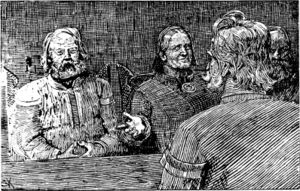- Sigurd Syr
-
Sigurd Syr (nórdico antiguo Sigurðr Sýr; noruego Sigurd Halvdansson) (m. 1018) fue un caudillo vikingo y rey en Ostlandet, Noruega.
Sigurd era co-príncipe de Ringerike, un antiguo reino de Noruega, en el actual condado de Buskerud. Por su matrimonio con Åsta Gudbrandsdatter, hija de Gudbrand Kula, era padrastro del rey Olaf II el Santo y padre de Harald III de Noruega. Su apodo Sýr puede traducirse como "sembrar", pero se desconoce la razón. El historiador P.A. Munch sugiere que era por su actividad agrícola al harar la tierra como un cerdo, pero bien podría ser por cualquier otro motivo.[1]
Las sagas son testimonios de la vida de muchos personajes contemporáneos, en particular la saga Heimskringla del escaldo islandés Snorri Sturluson que, en el caso de Sigurd Syr, menciona que era hijo de Sigurd Rise rey de Hadafylke y por lo tanto nieto del rey Harald I de Noruega.[2] No obstante, muchos historiadores modernos coinciden que la genealogía del rey Harald es inventada en su mayor parte.[3] [4] Existen dudas sobre la figura de Sigurd Rise, hijo del rey Harald y una mujer sami llamada Snæfrid.[5]
Heimskringla cita que Sigurd Syr era un hombre prudente, taciturno y generalmente modesto, aunque era rico. Era conocido como un buen gestor de sus propiedades, donde se involucraba personalemente, también era un hombre sabio y pacífico. No fue aficionado a la pompa y ceremoniales de la corte, pero jugó su papel en la historia como se esperaba.[6]
Sigurd Syr fue bautizado como cristiano en 998. Según Heimskringla, el rey Olaf I de Noruega fue a Ringerike difundiendo su fe, Sigurd Syr y su esposa permitieron su bautizo voluntariamente. Sigurd no era personalmente ambicioso, pero sin embargo apoyó totalmente las ambiciones de su hijastro Olaf. En 1014, con éxito presentó una moción a sus pares, los otros reyes noruegos, para que apoyasen una nueva guerra contra Suecia, Dinamarca e Inglaterra que comenzó en 1015. Esta guerra era una causa particular del rey Olaf.[7]
Su hijo Halfdan Sigurdsson le sucedió en el gobierno de Hadafylke.
Referencias
- ↑ Claus Krag, "Sigurd Halvdansson Syr – utdypning", Store norske leksikon
- ↑ Snorri Sturluson, Heimskringla: History of the Kings of Norway, tr. Lee M. Hollander, The American-Scandinavian Foundation, Austin: University of Texas Press, 1964, repr. 1992, ISBN 0-292-73061-6, Saga de Óláf Tryggvason cap. 60 p. 200
- ↑ See Joan Turville-Petre, "The Genealogist and History: Ari to Snorri", Saga-Book 20 (1978-81), p. 7-23 (pdf), especialmente p. 15
- ↑ M. Sjöström, "Scandinavian medieval descendants of Charlemagne: A detailed genealogy of the issue of Agnes Haakonsdottir, of the so-called Fairhair dynasty", Foundations - Journal of the Foundation for Medieval Genealogy vol 2 (2007:4, Julio), p. 253-76
- ↑ Knut Helle, Cambridge History of Scandinavia, Volume I, Prehistory to 1520, Cambridge University Press, 2003, ISBN 0521472997 p. 191.
- ↑ Heimskringla ed. Hollander, St. Óláf's Saga cap. 33 p. 268.
- ↑ Sigwart Sörensen, Norway, New York: Collier, 1899, OCLC 474863147 p. 79-80.
Categorías:- Príncipes de Noruega
- Vikingos de Noruega
Wikimedia foundation. 2010.

